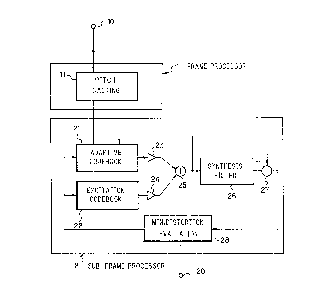Some of the information on this Web page has been provided by external sources. The Government of Canada is not responsible for the accuracy, reliability or currency of the information supplied by external sources. Users wishing to rely upon this information should consult directly with the source of the information. Content provided by external sources is not subject to official languages, privacy and accessibility requirements.
Any discrepancies in the text and image of the Claims and Abstract are due to differing posting times. Text of the Claims and Abstract are posted:
| (12) Patent: | (11) CA 2130877 |
|---|---|
| (54) English Title: | SPEECH PITCH CODING SYSTEM |
| (54) French Title: | SYSTEME DE CODAGE DE HAUTEURS DE SONS VOCAUX |
| Status: | Term Expired - Post Grant Beyond Limit |
| (51) International Patent Classification (IPC): |
|
|---|---|
| (72) Inventors : |
|
| (73) Owners : |
|
| (71) Applicants : |
|
| (74) Agent: | G. RONALD BELL & ASSOCIATES |
| (74) Associate agent: | |
| (45) Issued: | 1999-01-19 |
| (22) Filed Date: | 1994-08-25 |
| (41) Open to Public Inspection: | 1995-02-27 |
| Examination requested: | 1994-08-25 |
| Availability of licence: | N/A |
| Dedicated to the Public: | N/A |
| (25) Language of filing: | English |
| Patent Cooperation Treaty (PCT): | No |
|---|
| (30) Application Priority Data: | ||||||
|---|---|---|---|---|---|---|
|
A plurality of pitch period transition paths are extracted
by pitch tracking over a frame, and a path of minimum average
prediction gain over the frame is selected from the extracted
paths. A subsequent preliminary pitch selection may be executed
in a sub-frame processing to select a plurality of candidates
from the neighbourhood of the pitch of the transition path
selected for each sub-frame. The selection uses the inner
product of the input speech signal and codebook codevectors.
Finally, a pitch period having a minimum waveform distortion is
selected for each sub-frame.
Plusieurs parcours de transition d'un ton sont obtenus en mesurant le ton sur un certain intervalle, d'où on peut extraire une prédiction pour le gain minimal moyen de cet intervalle. Subséquemment, on peut choisir un ton de façon préliminaire lors de l'analyse d'un sous-intervalle, de façon à obtenir plusieurs choix possibles situés au voisinage du ton correspondant au parcours choisi pour ce sous-intervalle. Le choix s'effectue en effectuant le produit scalaire du signal sonore initial et de vecteurs d'un répertoire de codage. Finalement, on sélectionne un ton pour chaque sous-intervalle ayant pour résultat de minimiser la distorsion de l'impulsion d'onde.
Note: Claims are shown in the official language in which they were submitted.
Note: Descriptions are shown in the official language in which they were submitted.

2024-08-01:As part of the Next Generation Patents (NGP) transition, the Canadian Patents Database (CPD) now contains a more detailed Event History, which replicates the Event Log of our new back-office solution.
Please note that "Inactive:" events refers to events no longer in use in our new back-office solution.
For a clearer understanding of the status of the application/patent presented on this page, the site Disclaimer , as well as the definitions for Patent , Event History , Maintenance Fee and Payment History should be consulted.
| Description | Date |
|---|---|
| Inactive: Expired (new Act pat) | 2014-08-25 |
| Inactive: IPC expired | 2013-01-01 |
| Inactive: IPC expired | 2013-01-01 |
| Inactive: IPC expired | 2013-01-01 |
| Inactive: IPC deactivated | 2011-07-27 |
| Inactive: IPC deactivated | 2011-07-27 |
| Inactive: First IPC derived | 2006-03-11 |
| Inactive: IPC from MCD | 2006-03-11 |
| Inactive: IPC from MCD | 2006-03-11 |
| Inactive: IPC from MCD | 2006-03-11 |
| Grant by Issuance | 1999-01-19 |
| Letter Sent | 1998-09-03 |
| Amendment After Allowance Requirements Determined Compliant | 1998-09-03 |
| Inactive: Final fee received | 1998-06-29 |
| Pre-grant | 1998-06-29 |
| Inactive: Amendment after Allowance Fee Processed | 1998-06-26 |
| Amendment After Allowance (AAA) Received | 1998-06-26 |
| Letter Sent | 1997-12-31 |
| Notice of Allowance is Issued | 1997-12-31 |
| Notice of Allowance is Issued | 1997-12-31 |
| Inactive: Application prosecuted on TS as of Log entry date | 1997-12-18 |
| Inactive: Status info is complete as of Log entry date | 1997-12-18 |
| Inactive: First IPC assigned | 1997-12-11 |
| Inactive: IPC removed | 1997-12-11 |
| Inactive: IPC assigned | 1997-12-11 |
| Inactive: IPC removed | 1997-12-11 |
| Inactive: IPC assigned | 1997-12-11 |
| Inactive: Approved for allowance (AFA) | 1997-12-09 |
| Application Published (Open to Public Inspection) | 1995-02-27 |
| Request for Examination Requirements Determined Compliant | 1994-08-25 |
| All Requirements for Examination Determined Compliant | 1994-08-25 |
There is no abandonment history.
The last payment was received on 1998-08-17
Note : If the full payment has not been received on or before the date indicated, a further fee may be required which may be one of the following
Patent fees are adjusted on the 1st of January every year. The amounts above are the current amounts if received by December 31 of the current year.
Please refer to the CIPO
Patent Fees
web page to see all current fee amounts.
Note: Records showing the ownership history in alphabetical order.
| Current Owners on Record |
|---|
| NEC CORPORATION |
| Past Owners on Record |
|---|
| MASAHIRO SERIZAWA |